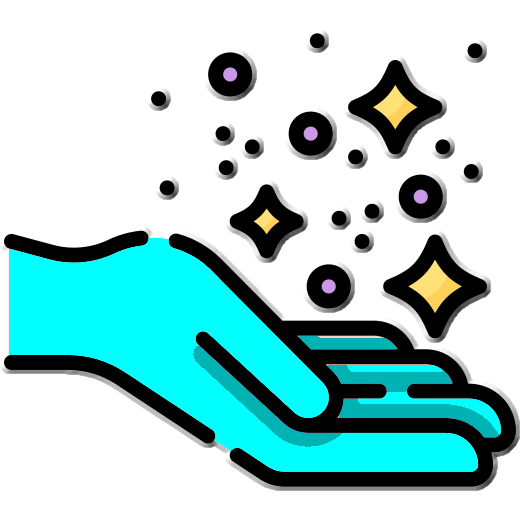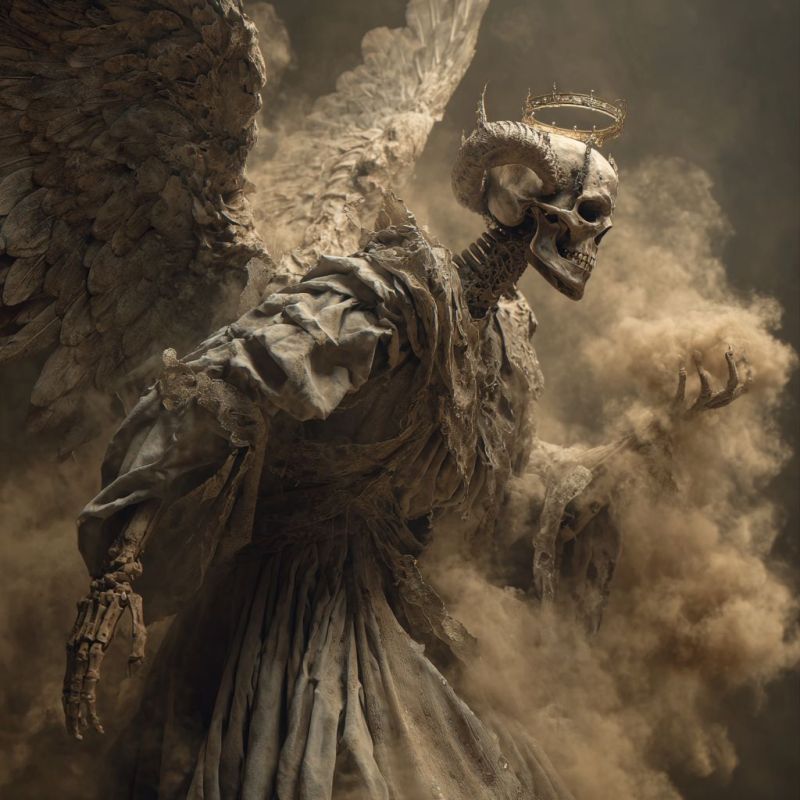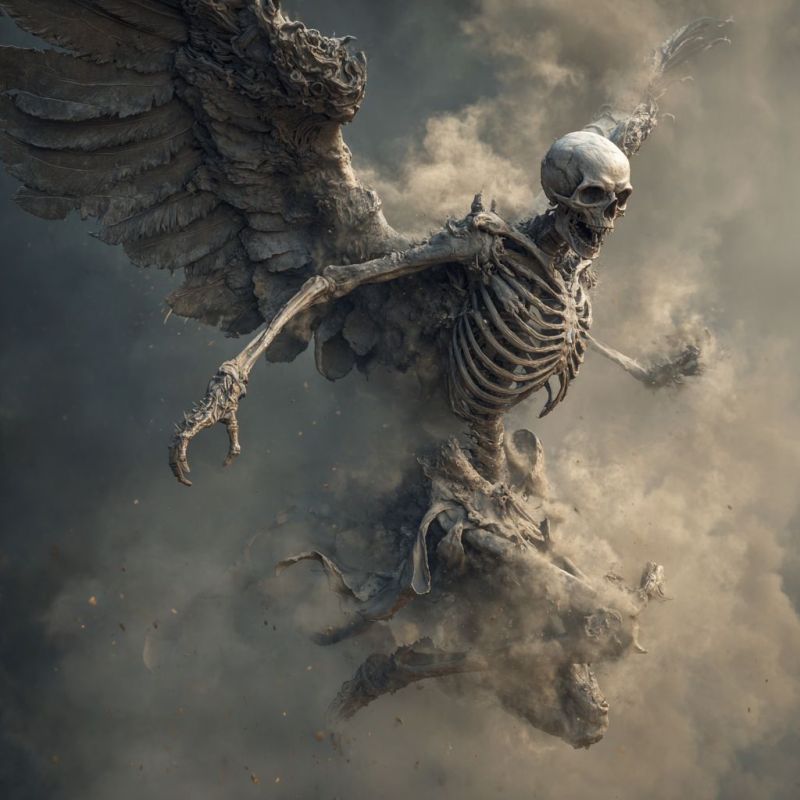 Natural Armor:
Natural Armor:-
Natural Armor +90 gp
 Abilities:
Abilities:-
Wave of Decay
 At Will Spell(s):
At Will Spell(s):-
Grim Hand
 0
0

-
Putrefy Touch
 0
0
 1
1

-
Skeletal Hands
 1
1

 Innate Spell(s) per Long Rest:
Innate Spell(s) per Long Rest:-
Animate Undead Pack
 1 Minute
6
1 Minute
6

-
Explosive Ghostflame
 3
3

-
Ghostflame Breath
 4
4

-
Summon Skeletal Minions
 2
2

 Monster Bits:
Monster Bits:-
18 Animal Bone0.03 gp
-
5 Necrotic Essence2 gp
-
18 Rotten Flesh0.05 gp
Bones draped in tattered, blackened feathers descend, each wingbeat shedding dust. Around it, grass curls into ash, trees splinter, and stone crumbles beneath the shadow of its hollow, unblinking gaze.
🌟👼 Angels: Celestial Guardians of Divine Order
Angels are radiant beings of ethereal grace, their presence a beacon of hope and divine will in the multiverse. ✨ Woven from the essence of celestial planes, they embody virtues—justice, mercy, courage—and serve as messengers, protectors, and enforcers of cosmic harmony. With shimmering wings and hearts ablaze with divine purpose, they stand against chaos and darkness, their beauty matched only by their resolve. In any campaign, angels are awe-inspiring allies or formidable foes, their actions shaping the balance of existence itself.
🏰 Celestial Hierarchy: Orders of Divinity
Angels are organized in a radiant hierarchy, each rank reflecting a facet of the divine. 🛡️ Cherubim, the lowest, guard sacred sites with unwavering vigilance, their forms often childlike yet potent. Seraphim, wreathed in flame, wield divine wrath, while Archangels, the pinnacle of celestial might, orchestrate cosmic battles and guide mortal heroes. Each order has unique roles—messengers, warriors, healers—and distinct powers, from radiant auras to reality-shaping miracles.
Game Masters can craft this hierarchy to suit their world, perhaps adding new ranks or tying angels to specific deities. The interplay between orders offers rich storytelling—rivalries, alliances, or quests to ascend the celestial ladder—inviting players to navigate the politics of divinity.
🕊️ Winged Messengers: Soaring on Divine Winds
An angel’s wings are their signature, a symbol of their celestial nature and a means to traverse planes with breathtaking agility. 🪶 Cherubim might bear soft, feathered wings, while Seraphim blaze with fiery plumes or radiant light. Archangels’ wings may shimmer like starfields, bending space itself. These wings allow angels to soar through skies, slip between dimensions, or hover with serene grace, their flight a spectacle that inspires awe or dread.
GMs can use wing designs to reflect an angel’s role or personality—golden wings for a healer, jagged light for a warrior. Their mobility makes them dynamic in encounters, swooping into battles or vanishing in a flash of divine light, challenging players to counter their aerial prowess.
⚔️ Instruments of Divine Wrath
When the cosmic order is threatened, angels unleash their full might as agents of divine retribution. 🌩️ Armed with heavenly blades, radiant spears, or pure celestial energy, they smite those who defy the balance—demons, tyrants, or rogue gods. Their divine magic can heal the broken, banish evil, or reshape battlefields with holy fire. A vengeful Seraphim might level a corrupted city, while an Archangel could rally armies against an abyssal horde.
Game Masters can position angels as climactic foes or powerful allies, their wrath a test of players’ morality or combat skill. Their interventions—whether to punish or protect—can drive campaigns, forcing players to weigh the cost of divine justice.
🌌 Celestial Patronage: Bonds of Divine Favor
Mortals can forge pacts with angelic orders, gaining blessings that shape their destiny. 🙏 Cherubim might grant protective wards, Seraphim bestow fiery strength, and Archangels offer visions of cosmic truth. These bonds tie players to celestial causes, granting abilities like healing light, divine insight, or auras that repel evil. However, patronage comes with duties—serving an angel’s mission or navigating their intricate politics.
GMs can make patronage a campaign cornerstone, with players earning an angel’s favor through quests or facing rival orders’ wrath. The choice of patron can define a character’s arc, tying their fate to the celestial struggle.
😈 The Abyssal Nemesis: Eternal Foes
Angels stand in eternal opposition to the Abyssal Nemesis—devils and demons who seek to plunge existence into chaos. 🩸 Devils weave tyranny with cold precision, while demons revel in raw destruction. This cosmic conflict sets the stage for epic battles, with angels clashing against infernal hordes or thwarting demonic incursions. Players may find themselves caught between these forces, choosing sides or seeking a fragile balance.
Game Masters can use this rivalry to fuel narratives—angels recruiting heroes to seal a demonic rift, or devils tempting players to betray their celestial allies. The moral tension adds depth, challenging players to define their own virtues.
🗝️ Quests of Divine Purpose
Angels offer players divine missions that elevate campaigns to mythic heights. 📜 Tasks might include delivering a sacred relic to a besieged temple, guarding a prophet from abyssal assassins, or uncovering a prophecy hidden in celestial archives. These quests immerse players in the celestial struggle, offering chances to wield divine artifacts, earn angelic boons, or face the consequences of failure.
GMs can craft quests to suit their story’s scale—from local heroics to multiversal stakes. An angel’s guidance adds weight to these missions, their presence a reminder of the divine forces at play.
🌠 Ascension and Redemption: Celestial Struggles
Even angels face trials, their divine nature tested by ambition or doubt. 👑 Some seek ascension to higher ranks, undertaking perilous quests to prove their worth. Others grapple with past transgressions—perhaps a fall from grace or a moment of mercy that defied their order. These struggles humanize angels, revealing their complexities and inviting players to aid or oppose their journeys.
Game Masters can weave these personal arcs into campaigns, with players helping an angel redeem a past sin or thwarting one’s reckless bid for power. Such stories add emotional depth, grounding celestial beings in relatable conflicts.
🏞️ Mysteries of the Celestial Plane
The celestial plane, home to angels, is a realm of shimmering spires, endless skies, and divine enigmas. 🌈 Its landscapes—crystal forests, rivers of light, or floating citadels—hold secrets like forgotten prophecies, relics of primal creation, or portals to other planes. Exploring this plane is a journey into the heart of divinity, where players might face trials to earn an angel’s trust or uncover truths that shake their faith.
GMs can design the plane as a campaign’s climax or a recurring haven, its mysteries driving quests for knowledge or power. Its beauty and danger make it a perfect backdrop for angelic encounters.
🌟 Defenders of the Cosmic Balance
Angels are the multiverse’s guardians, their radiant forms a bulwark against chaos and despair. 😇 In any world, they adapt—serving as divine emissaries in a high-fantasy realm, or subtle guides in a gritty saga. They are not just winged warriors but embodiments of hope, their virtues challenging players to rise above or question divine will. In campaigns, angels are pivotal, whether as allies granting holy might, adversaries enforcing rigid justice, or enigmatic figures whose motives spark debate.
To stand with or against an angel is to touch the divine, a choice that defines heroes and reshapes worlds. Their light endures, a call to protect the balance or forge a new order in the face of eternity. 🌌
 Immune to Status Effect:
Immune to Status Effect:-
 Exhausted
Exhausted -
 Sleeping
Sleeping -
 Starving
Starving
 Persistant/Permanent Status Effect:
Persistant/Permanent Status Effect:-
 Ageless
Ageless
😈🌪️ Demons: Abyssal Harbingers of Chaos
Demons are the raw, untamed essence of destruction, spawned in the roiling chaos of the Infinite Layers of the Abyss. 🕳️ These malevolent fiends are the embodiment of anarchy, their monstrous forms barely containing the seething energies of madness and ruin. From the lowliest dretch to the cataclysmic balor, demons surge forth as relentless agents of mayhem, driven by an insatiable urge to corrupt, defile, and annihilate. In any campaign, they are the ultimate force of disorder, their presence a storm that threatens to unravel the fabric of existence itself.
🌑 Unveiling the Abyssal Horrors: Origins of Chaos
Demons are born in the darkest depths of creation, where reality frays into a nightmare of endless turmoil. 🌀 The Abyss, a plane of infinite, ever-shifting layers, is their crucible, each layer a twisted reflection of chaos’s boundless nature. Here, demons emerge not from flesh but from the raw stuff of malevolence, their forms sculpted by the Abyss’s capricious will. They are the antithesis of order, their existence a rebellion against structure, harmony, and life itself, making them harbingers of doom in any world they invade.
Game Masters can root demons in their campaign’s cosmology—perhaps the Abyss is a wound in reality, a god’s shattered dream, or a prison for primal evils. Their origins offer flexibility, allowing demons to serve as cosmic threats, local terrors, or the fallout of a failed ritual.
🧬 Soulforge of the Abyss: Twisted Mortal Spirits
Demons are not born but forged, their essence drawn from mortal souls condemned to the Abyss’s torment. 🖤 These souls, stripped of their humanity, are those who in life embraced chaos—bandits who reveled in lawlessness, tyrants who sowed discord, or dreamers consumed by hateful obsessions. In the Abyss, they are unmade and remade, their spirits warped into nightmarish forms that reflect their sins: a glutton’s soul bloated into a gibbering dretch, a warrior’s rage forged into a hulking hezrou. This transformation severs all ties to their mortal past, leaving only a creature of pure, destructive instinct.
GMs can use this transformation to add depth—perhaps a demon retains a flicker of its mortal life, a vulnerability heroes can exploit, or a campaign hinges on preventing a soul’s descent into demonic rebirth. The process grounds demons in mortal folly, making their horror all the more personal.
🗡️ Wayward Believers: Champions of Anarchy
The souls that become demons were often those who rejected order in life, embracing the freedom of chaos or the power of destruction. 🩸 Some were anarchists who burned cities to ash, others philosophers who saw morality as a cage. Their beliefs, twisted by malice, drew them to the Abyss, where their ideals were distilled into pure malevolence. Even hateful thoughts—envy, wrath, despair—can coalesce into demonic forms, birthed from the collective darkness of mortal minds.
This origin allows GMs to craft demons that mirror their world’s conflicts. A setting plagued by rebellion might spawn demons of defiance, while one steeped in betrayal breeds fiends of deceit. Their mortal roots make them relatable yet alien, a twisted reflection of the campaign’s themes.
🦂 Varieties of Demonic Malevolence: A Legion of Terrors
Demons are as diverse as the chaos they embody, their forms a grotesque gallery of horror. 🕷️ Dretches shuffle as mindless, oozing wretches, while quasits skitter as venomous tricksters. Vrocks swoop with vulture-like savagery, and glabrezu tempt with honeyed lies and crushing claws. At the apex stand balors, towering infernos of rage whose mere presence scorches the earth. Each demon is a unique nightmare, its abilities—claws, venom, psychic screams, or reality-warping magic—reflecting the Abyss’s boundless creativity.
GMs can tailor demons to any encounter, from swarms of lesser fiends overwhelming a village to a single marilith cutting through armies with her bladed dance. Their variety ensures no two demonic threats feel the same, keeping players on edge.
👑 The Infernal Hierarchy: Lords of the Abyss
Amid the Abyss’s chaos, a brutal hierarchy reigns, crowned by the Demon Lords—beings of unfathomable power and cruelty. 🧠 Each lord rules a layer of the Abyss, from Demogorgon’s twin-headed madness to Orcus’s necromantic dominion. These titans command legions of lesser demons, their schemes shaking the multiverse as they war against each other and the forces of good. Their cunning rivals their might, weaving plots that span planes, their influence corrupting mortals and fiends alike.
Game Masters can use Demon Lords as campaign-defining villains, their layers serving as deadly dungeons or their cults as insidious threats. A lord’s presence elevates any story, turning a demonic incursion into an apocalyptic struggle.
⚔️ The Eternal Struggle: Chaos Against Cosmos
Demons are the eternal foes of order and virtue, their existence a relentless assault on the multiverse’s balance. 🌌 They corrupt the pure, shatter the just, and unravel the laws that bind reality. Every demon, from the lowliest manes to the mightiest lord, seeks to drown the world in chaos, their actions a tide that erodes hope and harmony. Heroes who face them are not merely fighting monsters but defending the very fabric of existence, their battles a stand against oblivion.
GMs can frame this struggle to suit their narrative—demons as invaders breaching a holy realm, saboteurs undermining a fragile peace, or tempters luring heroes to ruin. Their opposition to order makes them versatile antagonists, their chaos a catalyst for epic quests.
📜 Unraveling the Abyssal Mystery: Secrets of Demonology
To combat demons, heroes must delve into the forbidden art of demonology, unearthing secrets buried in ancient tomes or whispered by mad seers. 🧙♂️ Scholars seek the Abyss’s vulnerabilities—banishment rituals, wards forged in celestial light, or names that bind demons to obedience. Adventurers hunt relics to sever demonic anchors or lore to weaken a lord’s power. This pursuit is fraught with peril, for the Abyss’s knowledge corrupts as readily as its denizens, tempting the wise with power that leads to damnation.
Game Masters can make demonology a campaign’s heart, with players racing to uncover a lord’s true name or crafting a weapon to slay an unkillable fiend. The mystery ensures demons remain enigmatic, their defeat a triumph of knowledge and courage.
🌑 Engines of Anarchy
Demons are the pulse of chaos, their every act a scream against the ordered world. 😈 In any setting, they adapt—raging through war-torn planes as harbingers of ruin, or slinking through civilized lands as corruptors of the soul. In worlds like Zin, where shadows breed ancient evils, demons might pour from rifts in forgotten depths, their chaos threatening to drown the land in blood. They are the ultimate challenge, their malevolence a fire that tests heroes’ resolve, forcing them to confront not just monsters but the darkness within themselves.
To face a demon is to battle the Abyss itself, a foe that knows no restraint and seeks no mercy. Heroes who triumph may banish a lord or seal a rift, but the Abyss endures, its laughter a promise of chaos yet to come. 🌪️
 Special Senses:
Special Senses:-
 Fiendsight: +60
Fiendsight: +60
 Damage Type Immunity:
Damage Type Immunity:-
 Poison
Poison
 Immune to Status Effect:
Immune to Status Effect:-
 Poisoned
Poisoned


